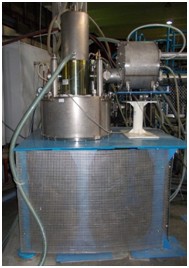High power ECRH Systems
The high power ECRH systems are important heating systems in tokamaksAditya and SST-1 to carry out various experiments related plasma breakdown, start-up, heating and current drive. There are various advantages of ECRH in tokamak plasma. The pre-ionization with ECRH helps in reliable start-up of tokamak even at higher error field in tokamak. It saves the volt-second consumption, which helps in elongation of plasma shots. The breakdown with ECRH is essential in superconducting tokamaks as sharp rise in ohmic (dI/dt) is not desirable because it may trigger quench in superconducting magnets. The ECRH also helps in MHD suppression and instability control like NTM suppression and saw-tooth control.
42GHz-500kW Gyrotron The normal frequency of operation of ECRH system varies from 28GHz to 170GHz depending on operating toroidal magnetic field of tokamak. The high power electron cyclotron resonance heating system consists of a microwave source (Gyrotron), corrugated waveguide based transmission line and mirror based launcher. The Gyrotron delivers megawatt level continuous power at high beam voltage ~ 40-60kV. The Gyrotrons are delicate high power microwave tube, the critical fault energy of a Gyrotronis ~10J which requires a dedicated reliable protection system. Thus the Gyrotron operation involves advance high voltage engineering for safe and reliable operation of system. ECRH Division has developed series ignitron based crowbar protection towards the safety of Gyrotrons. In Adityatokamak, a 28GHz/200kW ECRH system used and various experiments related to plasma breakdown and start-up were carried out at 0.75T to 0.85T operation. In SST-1 82.6GHz/200kW/CW ECRH system would be used to carry out experiments at 1.5T and 3.0T operation. The Gyrotron has been commissioned on dummy load for pulsed and CW operation. The ECRH system is further upgraded and 42GHz/500kW is commissioned on tokamak SST-1 and Aditya. The 42GHz ECRH system is an advance system which delivers power to both the tokamaks simultaneously. The transmission line system for 42GHz system consists of two switches, one switch is used to test Gyrotron on dummy load or transfer towards tokamak while other switch facilities to launch power either in SST-1 or in Aditya. Achievements: The ECRH division has various achievements and technology developmentsin the field of launchers, high voltage protection system and system integrationetc. The main technology developments are as follows: 1. Launcher development: All the launchers 28GHz for Adityatokamak, top and radial launcher for SST1 and composite launcher for SST-1 are designed, developed indigenously, tested and commissioned on tokamakAditya and SST-1. 2. Development of Series Ignitron Crowbar system: The indigenous development of two series ignitron crowbar system is a remarkable achievement towards safe and reliable operation of Gyrotron. Later various Ignitron crowbar system has been developed with different ignitrons. The 80kV ignitron crowbar system consists of two 50kV ignitrons connected in series. The system is also consists of R-C combination for static and dynamic compensation. The system has been successfully tested upto 80kV and operational with Gyrotron system 3. ECRH assisted breakdown in tokamakAditya: The 42GHz ECRH system has been used on tokamakAditya and second harmonic ECRH assisted breakdown has been achieved successfully at low loop voltage. The normal loop voltage of Aditya is ~22V, the successful normal plasma discharge assisted with ECRH has been achieved at low loop voltage up to ~7V. 4. ECRH assisted breakdown in SST-1: The SST is superconducting tokamak and hence loop voltage is limited ~3-4V. The ECRH assisted successful breakdown has been achieved in SST-1 at loop voltage ~3V. The first plasma in SST1 has been achieved with the assisted breakdown through ECRH. Approximately 300kW ECRH power is launched around 30ms before the loop voltage and successful breakdown is achieved with pre-ionized density ~2x1012/cc. The SST has been operated at 0.75T & 1.5T and ECRH assisted breakdown has been achieved successfully in both the operating magnetic fields. |


